Leadership and Management in Adult Care: A Comprehensive Report
VerifiedAdded on 2023/06/09
|8
|2019
|431
Report
AI Summary
This report provides an in-depth analysis of leadership and management principles within the context of adult care. It begins by differentiating between leadership and management, highlighting their distinct roles and focuses. The report then delves into various leadership theories, such as the Great Man theory, trait theory, behavioral theory, transactional and management theory, relationship theory, and situational leadership, providing insights into their characteristics and applications. Similarly, it explores management models, including scientific management, administrative management, bureaucratic management, human relations, and systems management theories. The report also examines the impact of external influences on leadership and management within adult care, such as healthcare system complexities, patient cooperation, resource availability and the importance of effective communication. Furthermore, it discusses the operational functions of management, the role of operational activities in delivering care, and the influence of leadership and management on the quality of adult care services. Finally, the report concludes with a discussion on justified actions for personal development as a leader and manager in an adult care setting, emphasizing the importance of skilled teams and a culture that promotes innovation and problem-solving.
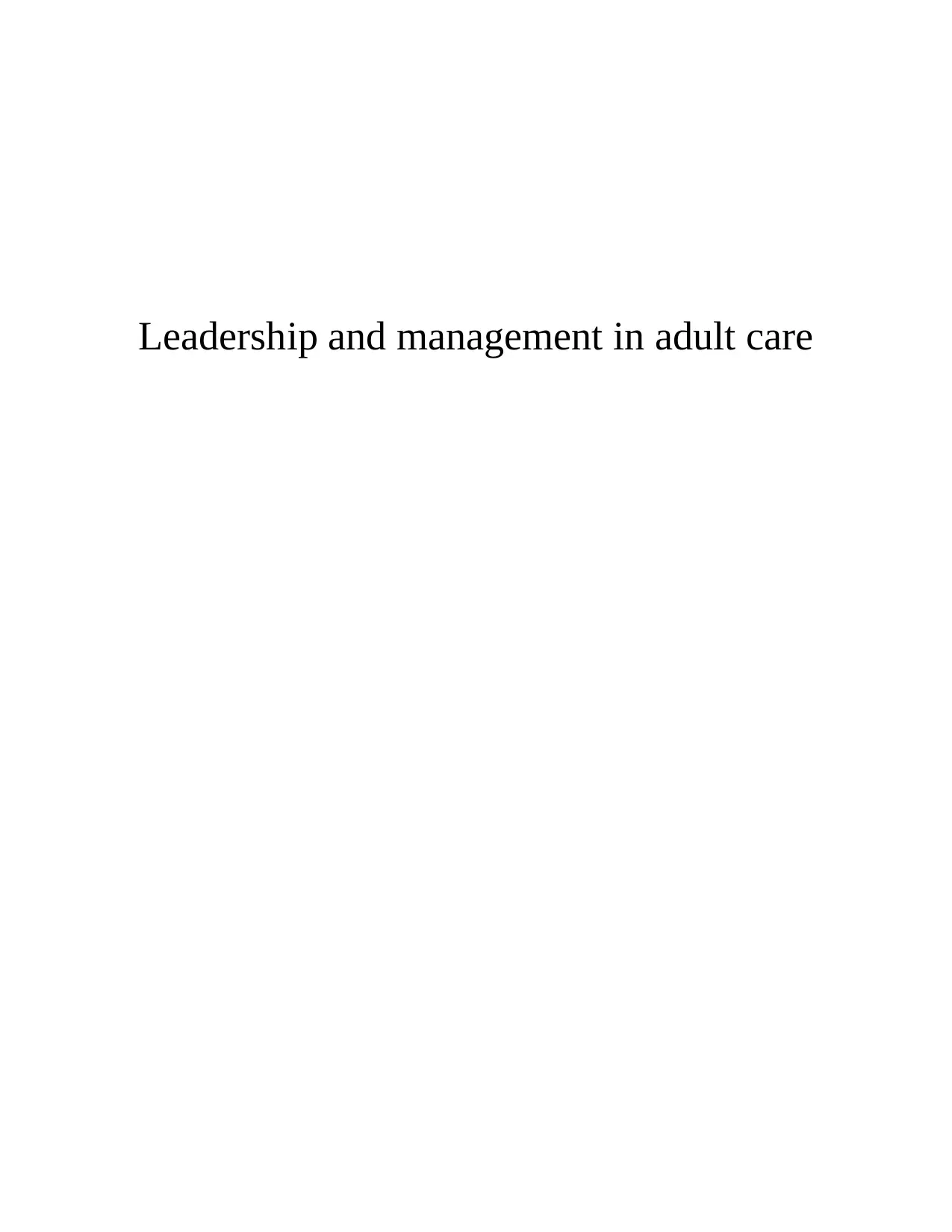
Leadership and management in adult care
Paraphrase This Document
Need a fresh take? Get an instant paraphrase of this document with our AI Paraphraser
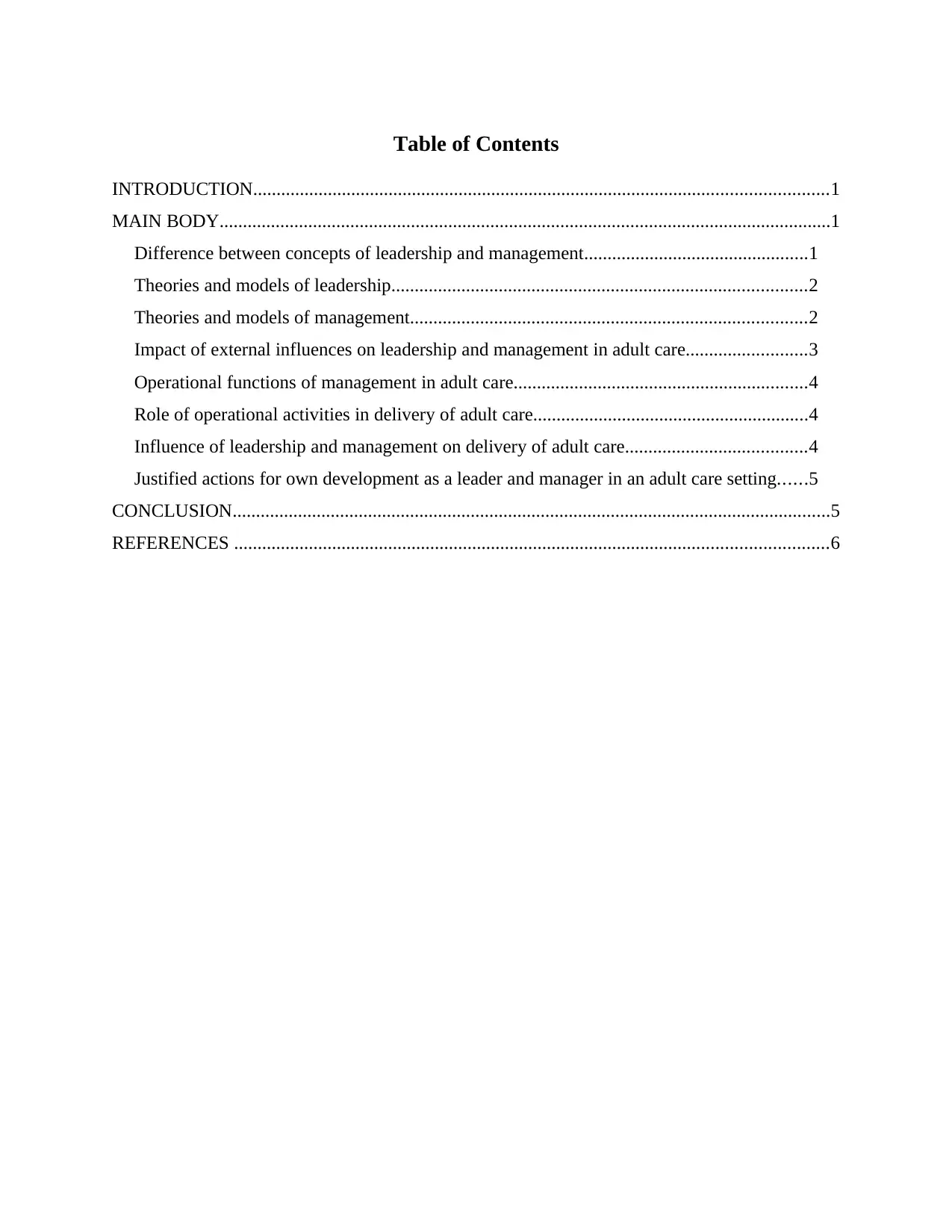
Table of Contents
INTRODUCTION...........................................................................................................................1
MAIN BODY...................................................................................................................................1
Difference between concepts of leadership and management................................................1
Theories and models of leadership.........................................................................................2
Theories and models of management.....................................................................................2
Impact of external influences on leadership and management in adult care..........................3
Operational functions of management in adult care...............................................................4
Role of operational activities in delivery of adult care...........................................................4
Influence of leadership and management on delivery of adult care.......................................4
Justified actions for own development as a leader and manager in an adult care setting......5
CONCLUSION................................................................................................................................5
REFERENCES ...............................................................................................................................6
INTRODUCTION...........................................................................................................................1
MAIN BODY...................................................................................................................................1
Difference between concepts of leadership and management................................................1
Theories and models of leadership.........................................................................................2
Theories and models of management.....................................................................................2
Impact of external influences on leadership and management in adult care..........................3
Operational functions of management in adult care...............................................................4
Role of operational activities in delivery of adult care...........................................................4
Influence of leadership and management on delivery of adult care.......................................4
Justified actions for own development as a leader and manager in an adult care setting......5
CONCLUSION................................................................................................................................5
REFERENCES ...............................................................................................................................6
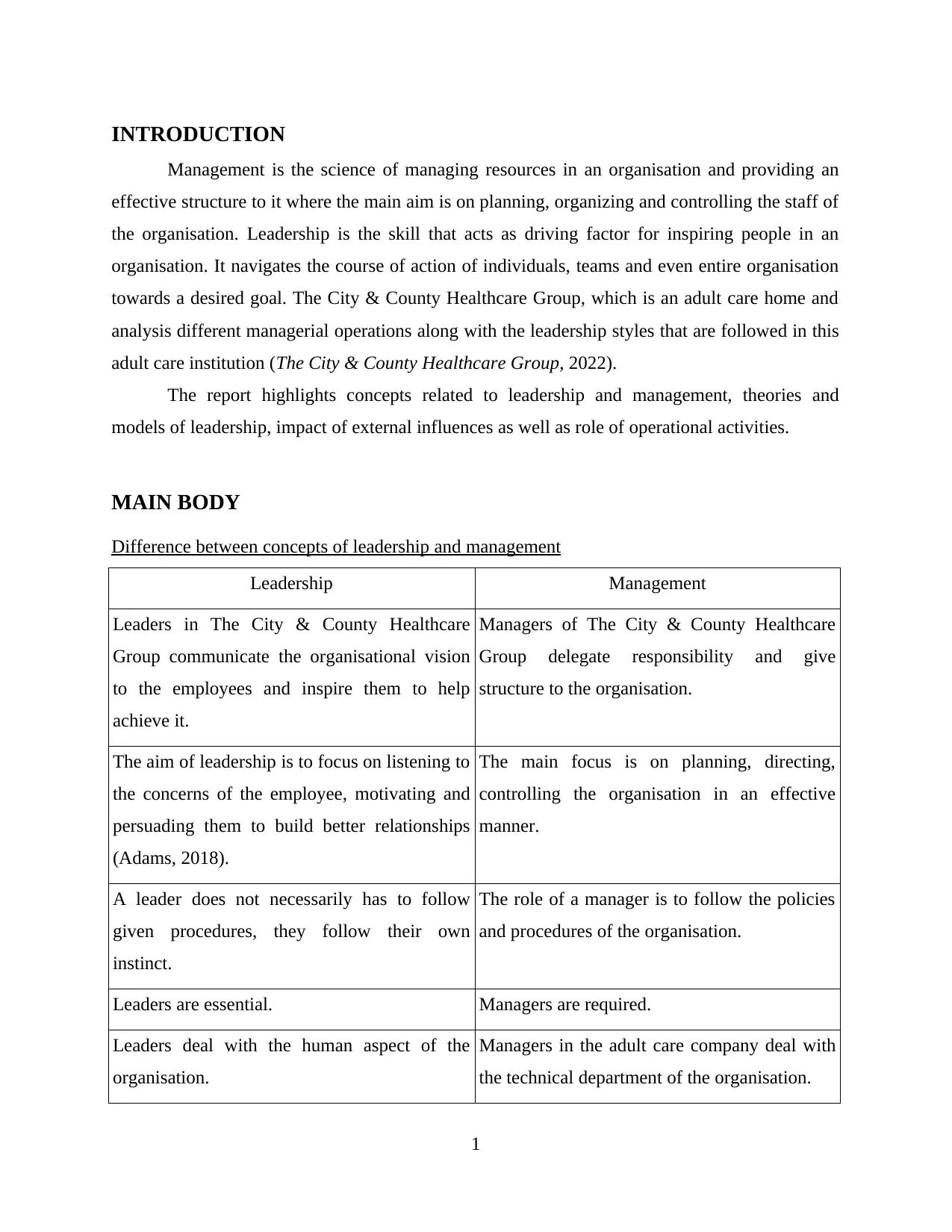
INTRODUCTION
Management is the science of managing resources in an organisation and providing an
effective structure to it where the main aim is on planning, organizing and controlling the staff of
the organisation. Leadership is the skill that acts as driving factor for inspiring people in an
organisation. It navigates the course of action of individuals, teams and even entire organisation
towards a desired goal. The City & County Healthcare Group, which is an adult care home and
analysis different managerial operations along with the leadership styles that are followed in this
adult care institution (The City & County Healthcare Group, 2022).
The report highlights concepts related to leadership and management, theories and
models of leadership, impact of external influences as well as role of operational activities.
MAIN BODY
Difference between concepts of leadership and management
Leadership Management
Leaders in The City & County Healthcare
Group communicate the organisational vision
to the employees and inspire them to help
achieve it.
Managers of The City & County Healthcare
Group delegate responsibility and give
structure to the organisation.
The aim of leadership is to focus on listening to
the concerns of the employee, motivating and
persuading them to build better relationships
(Adams, 2018).
The main focus is on planning, directing,
controlling the organisation in an effective
manner.
A leader does not necessarily has to follow
given procedures, they follow their own
instinct.
The role of a manager is to follow the policies
and procedures of the organisation.
Leaders are essential. Managers are required.
Leaders deal with the human aspect of the
organisation.
Managers in the adult care company deal with
the technical department of the organisation.
1
Management is the science of managing resources in an organisation and providing an
effective structure to it where the main aim is on planning, organizing and controlling the staff of
the organisation. Leadership is the skill that acts as driving factor for inspiring people in an
organisation. It navigates the course of action of individuals, teams and even entire organisation
towards a desired goal. The City & County Healthcare Group, which is an adult care home and
analysis different managerial operations along with the leadership styles that are followed in this
adult care institution (The City & County Healthcare Group, 2022).
The report highlights concepts related to leadership and management, theories and
models of leadership, impact of external influences as well as role of operational activities.
MAIN BODY
Difference between concepts of leadership and management
Leadership Management
Leaders in The City & County Healthcare
Group communicate the organisational vision
to the employees and inspire them to help
achieve it.
Managers of The City & County Healthcare
Group delegate responsibility and give
structure to the organisation.
The aim of leadership is to focus on listening to
the concerns of the employee, motivating and
persuading them to build better relationships
(Adams, 2018).
The main focus is on planning, directing,
controlling the organisation in an effective
manner.
A leader does not necessarily has to follow
given procedures, they follow their own
instinct.
The role of a manager is to follow the policies
and procedures of the organisation.
Leaders are essential. Managers are required.
Leaders deal with the human aspect of the
organisation.
Managers in the adult care company deal with
the technical department of the organisation.
1
⊘ This is a preview!⊘
Do you want full access?
Subscribe today to unlock all pages.

Trusted by 1+ million students worldwide
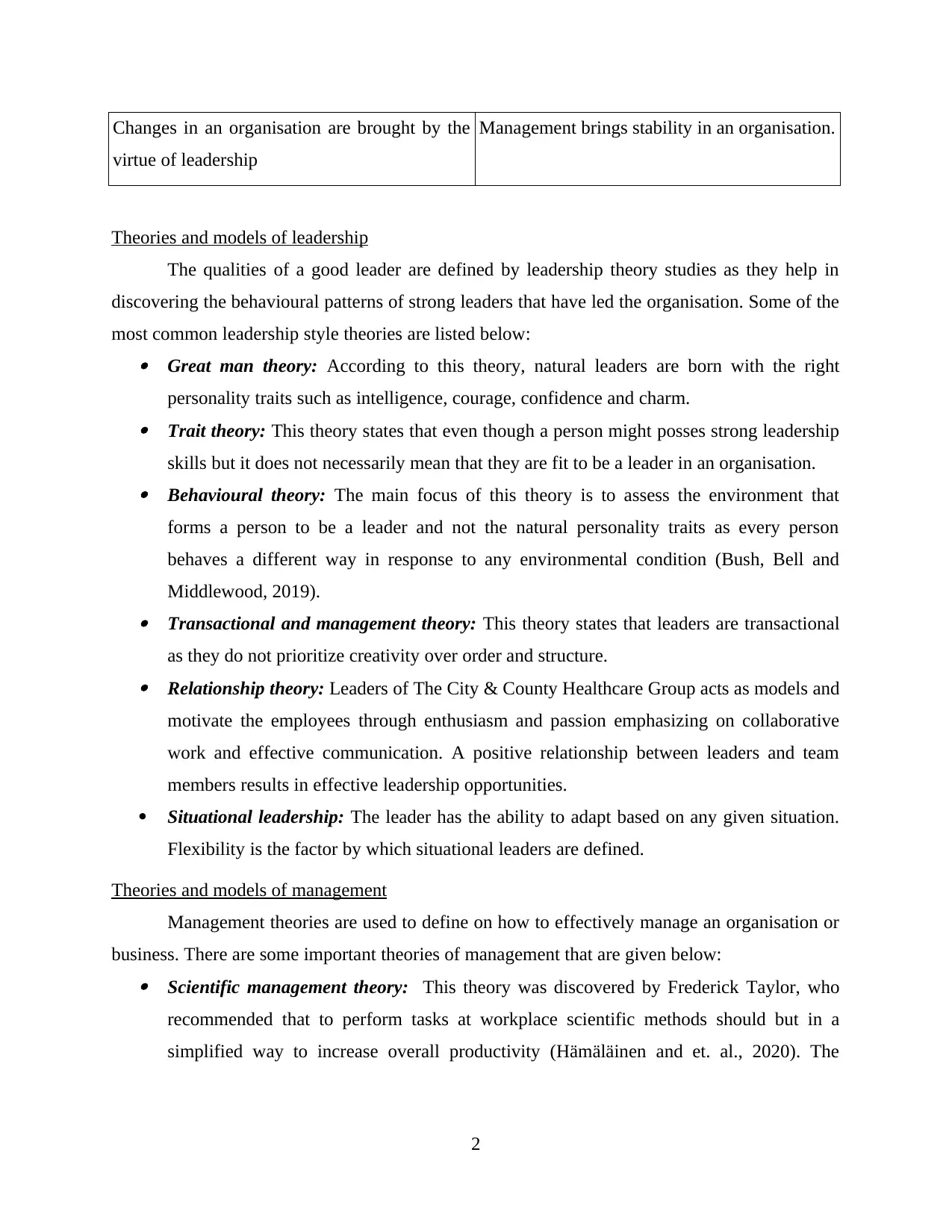
Changes in an organisation are brought by the
virtue of leadership
Management brings stability in an organisation.
Theories and models of leadership
The qualities of a good leader are defined by leadership theory studies as they help in
discovering the behavioural patterns of strong leaders that have led the organisation. Some of the
most common leadership style theories are listed below: Great man theory: According to this theory, natural leaders are born with the right
personality traits such as intelligence, courage, confidence and charm. Trait theory: This theory states that even though a person might posses strong leadership
skills but it does not necessarily mean that they are fit to be a leader in an organisation. Behavioural theory: The main focus of this theory is to assess the environment that
forms a person to be a leader and not the natural personality traits as every person
behaves a different way in response to any environmental condition (Bush, Bell and
Middlewood, 2019). Transactional and management theory: This theory states that leaders are transactional
as they do not prioritize creativity over order and structure. Relationship theory: Leaders of The City & County Healthcare Group acts as models and
motivate the employees through enthusiasm and passion emphasizing on collaborative
work and effective communication. A positive relationship between leaders and team
members results in effective leadership opportunities.
Situational leadership: The leader has the ability to adapt based on any given situation.
Flexibility is the factor by which situational leaders are defined.
Theories and models of management
Management theories are used to define on how to effectively manage an organisation or
business. There are some important theories of management that are given below: Scientific management theory: This theory was discovered by Frederick Taylor, who
recommended that to perform tasks at workplace scientific methods should but in a
simplified way to increase overall productivity (Hämäläinen and et. al., 2020). The
2
virtue of leadership
Management brings stability in an organisation.
Theories and models of leadership
The qualities of a good leader are defined by leadership theory studies as they help in
discovering the behavioural patterns of strong leaders that have led the organisation. Some of the
most common leadership style theories are listed below: Great man theory: According to this theory, natural leaders are born with the right
personality traits such as intelligence, courage, confidence and charm. Trait theory: This theory states that even though a person might posses strong leadership
skills but it does not necessarily mean that they are fit to be a leader in an organisation. Behavioural theory: The main focus of this theory is to assess the environment that
forms a person to be a leader and not the natural personality traits as every person
behaves a different way in response to any environmental condition (Bush, Bell and
Middlewood, 2019). Transactional and management theory: This theory states that leaders are transactional
as they do not prioritize creativity over order and structure. Relationship theory: Leaders of The City & County Healthcare Group acts as models and
motivate the employees through enthusiasm and passion emphasizing on collaborative
work and effective communication. A positive relationship between leaders and team
members results in effective leadership opportunities.
Situational leadership: The leader has the ability to adapt based on any given situation.
Flexibility is the factor by which situational leaders are defined.
Theories and models of management
Management theories are used to define on how to effectively manage an organisation or
business. There are some important theories of management that are given below: Scientific management theory: This theory was discovered by Frederick Taylor, who
recommended that to perform tasks at workplace scientific methods should but in a
simplified way to increase overall productivity (Hämäläinen and et. al., 2020). The
2
Paraphrase This Document
Need a fresh take? Get an instant paraphrase of this document with our AI Paraphraser
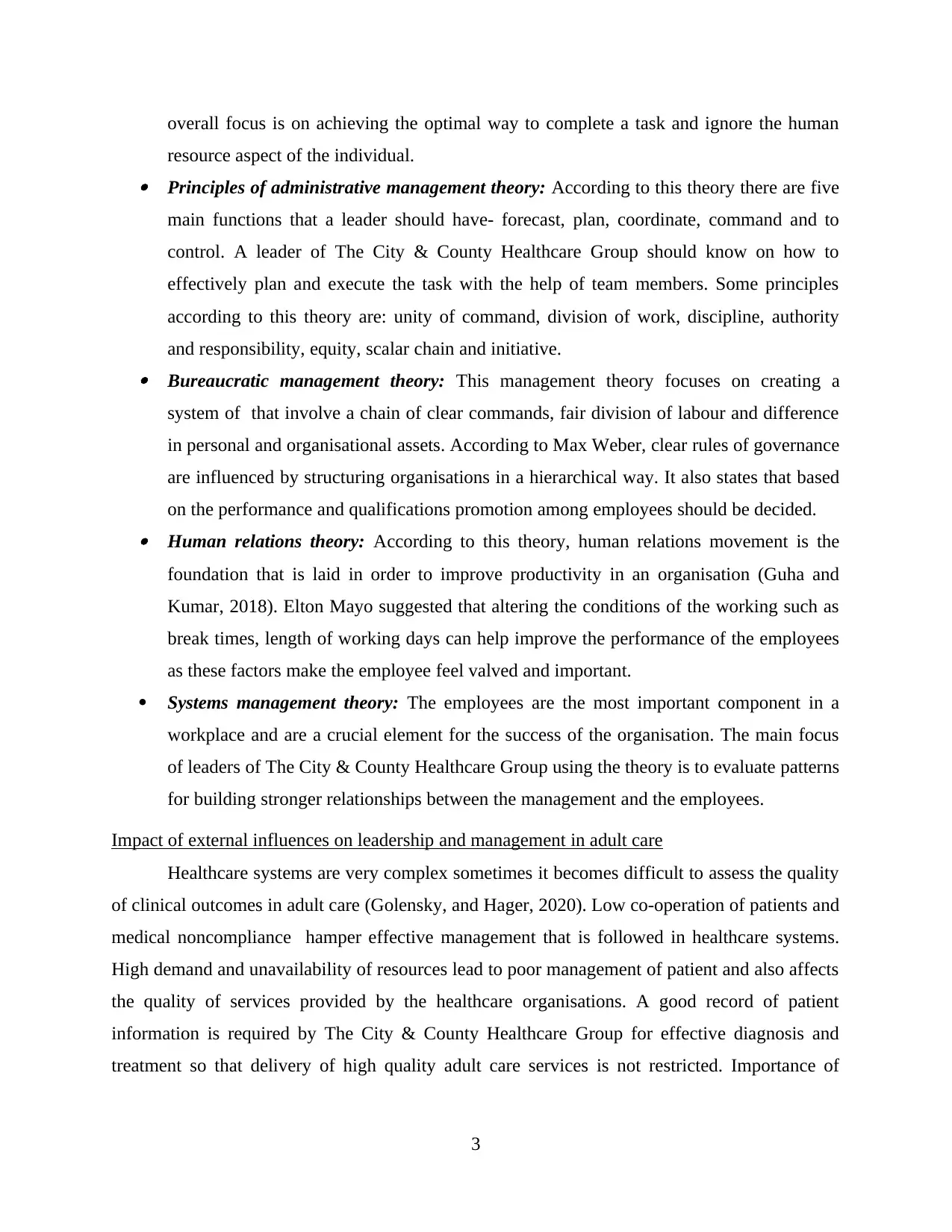
overall focus is on achieving the optimal way to complete a task and ignore the human
resource aspect of the individual. Principles of administrative management theory: According to this theory there are five
main functions that a leader should have- forecast, plan, coordinate, command and to
control. A leader of The City & County Healthcare Group should know on how to
effectively plan and execute the task with the help of team members. Some principles
according to this theory are: unity of command, division of work, discipline, authority
and responsibility, equity, scalar chain and initiative. Bureaucratic management theory: This management theory focuses on creating a
system of that involve a chain of clear commands, fair division of labour and difference
in personal and organisational assets. According to Max Weber, clear rules of governance
are influenced by structuring organisations in a hierarchical way. It also states that based
on the performance and qualifications promotion among employees should be decided. Human relations theory: According to this theory, human relations movement is the
foundation that is laid in order to improve productivity in an organisation (Guha and
Kumar, 2018). Elton Mayo suggested that altering the conditions of the working such as
break times, length of working days can help improve the performance of the employees
as these factors make the employee feel valved and important.
Systems management theory: The employees are the most important component in a
workplace and are a crucial element for the success of the organisation. The main focus
of leaders of The City & County Healthcare Group using the theory is to evaluate patterns
for building stronger relationships between the management and the employees.
Impact of external influences on leadership and management in adult care
Healthcare systems are very complex sometimes it becomes difficult to assess the quality
of clinical outcomes in adult care (Golensky, and Hager, 2020). Low co-operation of patients and
medical noncompliance hamper effective management that is followed in healthcare systems.
High demand and unavailability of resources lead to poor management of patient and also affects
the quality of services provided by the healthcare organisations. A good record of patient
information is required by The City & County Healthcare Group for effective diagnosis and
treatment so that delivery of high quality adult care services is not restricted. Importance of
3
resource aspect of the individual. Principles of administrative management theory: According to this theory there are five
main functions that a leader should have- forecast, plan, coordinate, command and to
control. A leader of The City & County Healthcare Group should know on how to
effectively plan and execute the task with the help of team members. Some principles
according to this theory are: unity of command, division of work, discipline, authority
and responsibility, equity, scalar chain and initiative. Bureaucratic management theory: This management theory focuses on creating a
system of that involve a chain of clear commands, fair division of labour and difference
in personal and organisational assets. According to Max Weber, clear rules of governance
are influenced by structuring organisations in a hierarchical way. It also states that based
on the performance and qualifications promotion among employees should be decided. Human relations theory: According to this theory, human relations movement is the
foundation that is laid in order to improve productivity in an organisation (Guha and
Kumar, 2018). Elton Mayo suggested that altering the conditions of the working such as
break times, length of working days can help improve the performance of the employees
as these factors make the employee feel valved and important.
Systems management theory: The employees are the most important component in a
workplace and are a crucial element for the success of the organisation. The main focus
of leaders of The City & County Healthcare Group using the theory is to evaluate patterns
for building stronger relationships between the management and the employees.
Impact of external influences on leadership and management in adult care
Healthcare systems are very complex sometimes it becomes difficult to assess the quality
of clinical outcomes in adult care (Golensky, and Hager, 2020). Low co-operation of patients and
medical noncompliance hamper effective management that is followed in healthcare systems.
High demand and unavailability of resources lead to poor management of patient and also affects
the quality of services provided by the healthcare organisations. A good record of patient
information is required by The City & County Healthcare Group for effective diagnosis and
treatment so that delivery of high quality adult care services is not restricted. Importance of
3
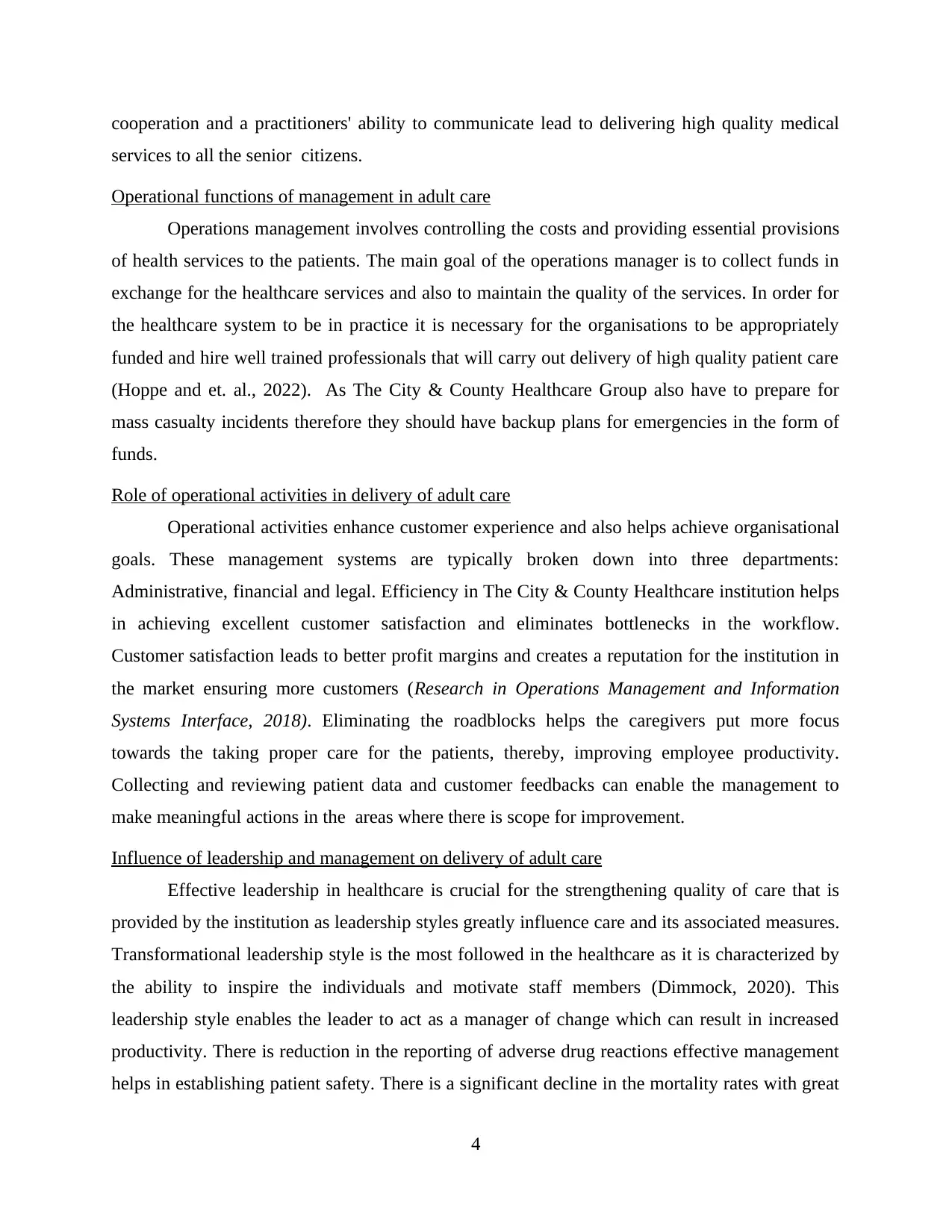
cooperation and a practitioners' ability to communicate lead to delivering high quality medical
services to all the senior citizens.
Operational functions of management in adult care
Operations management involves controlling the costs and providing essential provisions
of health services to the patients. The main goal of the operations manager is to collect funds in
exchange for the healthcare services and also to maintain the quality of the services. In order for
the healthcare system to be in practice it is necessary for the organisations to be appropriately
funded and hire well trained professionals that will carry out delivery of high quality patient care
(Hoppe and et. al., 2022). As The City & County Healthcare Group also have to prepare for
mass casualty incidents therefore they should have backup plans for emergencies in the form of
funds.
Role of operational activities in delivery of adult care
Operational activities enhance customer experience and also helps achieve organisational
goals. These management systems are typically broken down into three departments:
Administrative, financial and legal. Efficiency in The City & County Healthcare institution helps
in achieving excellent customer satisfaction and eliminates bottlenecks in the workflow.
Customer satisfaction leads to better profit margins and creates a reputation for the institution in
the market ensuring more customers (Research in Operations Management and Information
Systems Interface, 2018). Eliminating the roadblocks helps the caregivers put more focus
towards the taking proper care for the patients, thereby, improving employee productivity.
Collecting and reviewing patient data and customer feedbacks can enable the management to
make meaningful actions in the areas where there is scope for improvement.
Influence of leadership and management on delivery of adult care
Effective leadership in healthcare is crucial for the strengthening quality of care that is
provided by the institution as leadership styles greatly influence care and its associated measures.
Transformational leadership style is the most followed in the healthcare as it is characterized by
the ability to inspire the individuals and motivate staff members (Dimmock, 2020). This
leadership style enables the leader to act as a manager of change which can result in increased
productivity. There is reduction in the reporting of adverse drug reactions effective management
helps in establishing patient safety. There is a significant decline in the mortality rates with great
4
services to all the senior citizens.
Operational functions of management in adult care
Operations management involves controlling the costs and providing essential provisions
of health services to the patients. The main goal of the operations manager is to collect funds in
exchange for the healthcare services and also to maintain the quality of the services. In order for
the healthcare system to be in practice it is necessary for the organisations to be appropriately
funded and hire well trained professionals that will carry out delivery of high quality patient care
(Hoppe and et. al., 2022). As The City & County Healthcare Group also have to prepare for
mass casualty incidents therefore they should have backup plans for emergencies in the form of
funds.
Role of operational activities in delivery of adult care
Operational activities enhance customer experience and also helps achieve organisational
goals. These management systems are typically broken down into three departments:
Administrative, financial and legal. Efficiency in The City & County Healthcare institution helps
in achieving excellent customer satisfaction and eliminates bottlenecks in the workflow.
Customer satisfaction leads to better profit margins and creates a reputation for the institution in
the market ensuring more customers (Research in Operations Management and Information
Systems Interface, 2018). Eliminating the roadblocks helps the caregivers put more focus
towards the taking proper care for the patients, thereby, improving employee productivity.
Collecting and reviewing patient data and customer feedbacks can enable the management to
make meaningful actions in the areas where there is scope for improvement.
Influence of leadership and management on delivery of adult care
Effective leadership in healthcare is crucial for the strengthening quality of care that is
provided by the institution as leadership styles greatly influence care and its associated measures.
Transformational leadership style is the most followed in the healthcare as it is characterized by
the ability to inspire the individuals and motivate staff members (Dimmock, 2020). This
leadership style enables the leader to act as a manager of change which can result in increased
productivity. There is reduction in the reporting of adverse drug reactions effective management
helps in establishing patient safety. There is a significant decline in the mortality rates with great
4
⊘ This is a preview!⊘
Do you want full access?
Subscribe today to unlock all pages.

Trusted by 1+ million students worldwide
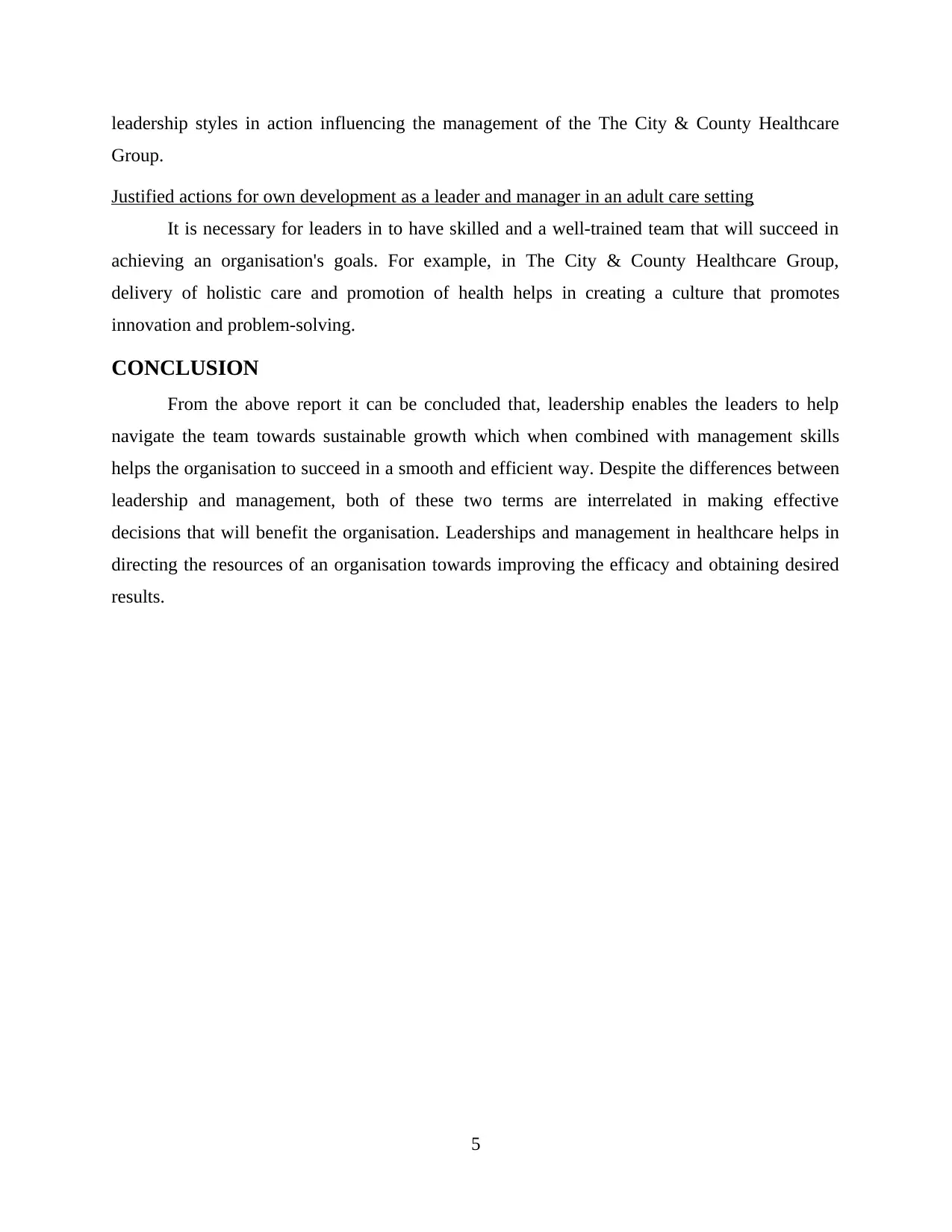
leadership styles in action influencing the management of the The City & County Healthcare
Group.
Justified actions for own development as a leader and manager in an adult care setting
It is necessary for leaders in to have skilled and a well-trained team that will succeed in
achieving an organisation's goals. For example, in The City & County Healthcare Group,
delivery of holistic care and promotion of health helps in creating a culture that promotes
innovation and problem-solving.
CONCLUSION
From the above report it can be concluded that, leadership enables the leaders to help
navigate the team towards sustainable growth which when combined with management skills
helps the organisation to succeed in a smooth and efficient way. Despite the differences between
leadership and management, both of these two terms are interrelated in making effective
decisions that will benefit the organisation. Leaderships and management in healthcare helps in
directing the resources of an organisation towards improving the efficacy and obtaining desired
results.
5
Group.
Justified actions for own development as a leader and manager in an adult care setting
It is necessary for leaders in to have skilled and a well-trained team that will succeed in
achieving an organisation's goals. For example, in The City & County Healthcare Group,
delivery of holistic care and promotion of health helps in creating a culture that promotes
innovation and problem-solving.
CONCLUSION
From the above report it can be concluded that, leadership enables the leaders to help
navigate the team towards sustainable growth which when combined with management skills
helps the organisation to succeed in a smooth and efficient way. Despite the differences between
leadership and management, both of these two terms are interrelated in making effective
decisions that will benefit the organisation. Leaderships and management in healthcare helps in
directing the resources of an organisation towards improving the efficacy and obtaining desired
results.
5
Paraphrase This Document
Need a fresh take? Get an instant paraphrase of this document with our AI Paraphraser
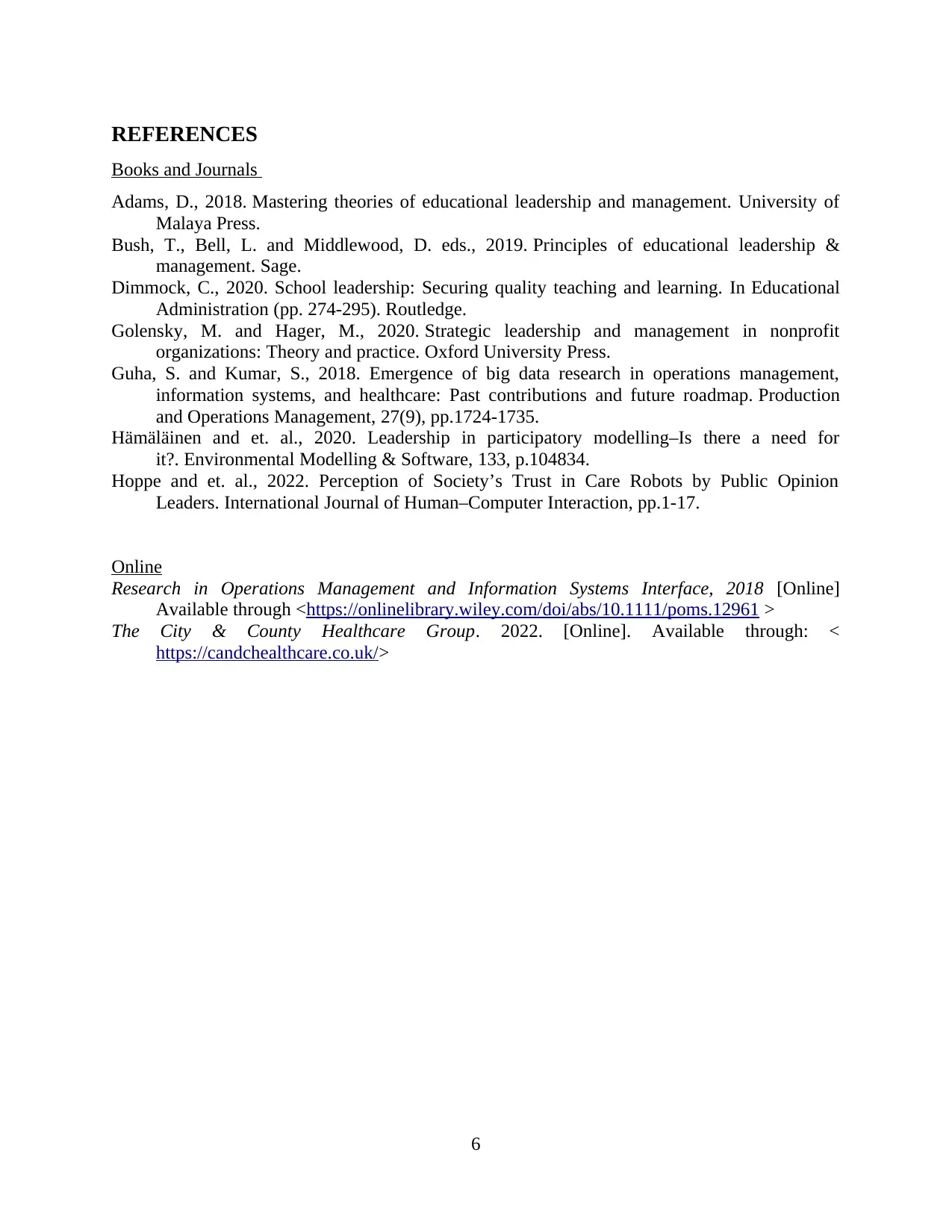
REFERENCES
Books and Journals
Adams, D., 2018. Mastering theories of educational leadership and management. University of
Malaya Press.
Bush, T., Bell, L. and Middlewood, D. eds., 2019. Principles of educational leadership &
management. Sage.
Dimmock, C., 2020. School leadership: Securing quality teaching and learning. In Educational
Administration (pp. 274-295). Routledge.
Golensky, M. and Hager, M., 2020. Strategic leadership and management in nonprofit
organizations: Theory and practice. Oxford University Press.
Guha, S. and Kumar, S., 2018. Emergence of big data research in operations management,
information systems, and healthcare: Past contributions and future roadmap. Production
and Operations Management, 27(9), pp.1724-1735.
Hämäläinen and et. al., 2020. Leadership in participatory modelling–Is there a need for
it?. Environmental Modelling & Software, 133, p.104834.
Hoppe and et. al., 2022. Perception of Society’s Trust in Care Robots by Public Opinion
Leaders. International Journal of Human–Computer Interaction, pp.1-17.
Online
Research in Operations Management and Information Systems Interface, 2018 [Online]
Available through <https://onlinelibrary.wiley.com/doi/abs/10.1111/poms.12961 >
The City & County Healthcare Group. 2022. [Online]. Available through: <
https://candchealthcare.co.uk/>
6
Books and Journals
Adams, D., 2018. Mastering theories of educational leadership and management. University of
Malaya Press.
Bush, T., Bell, L. and Middlewood, D. eds., 2019. Principles of educational leadership &
management. Sage.
Dimmock, C., 2020. School leadership: Securing quality teaching and learning. In Educational
Administration (pp. 274-295). Routledge.
Golensky, M. and Hager, M., 2020. Strategic leadership and management in nonprofit
organizations: Theory and practice. Oxford University Press.
Guha, S. and Kumar, S., 2018. Emergence of big data research in operations management,
information systems, and healthcare: Past contributions and future roadmap. Production
and Operations Management, 27(9), pp.1724-1735.
Hämäläinen and et. al., 2020. Leadership in participatory modelling–Is there a need for
it?. Environmental Modelling & Software, 133, p.104834.
Hoppe and et. al., 2022. Perception of Society’s Trust in Care Robots by Public Opinion
Leaders. International Journal of Human–Computer Interaction, pp.1-17.
Online
Research in Operations Management and Information Systems Interface, 2018 [Online]
Available through <https://onlinelibrary.wiley.com/doi/abs/10.1111/poms.12961 >
The City & County Healthcare Group. 2022. [Online]. Available through: <
https://candchealthcare.co.uk/>
6
1 out of 8
Related Documents
Your All-in-One AI-Powered Toolkit for Academic Success.
+13062052269
info@desklib.com
Available 24*7 on WhatsApp / Email
![[object Object]](/_next/static/media/star-bottom.7253800d.svg)
Unlock your academic potential
Copyright © 2020–2025 A2Z Services. All Rights Reserved. Developed and managed by ZUCOL.





